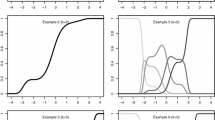Abstract
The partial credit model, developed by Masters (1982), is a unidimensional latent trait model for responses scored in two or more ordered categories. In the present paper some extensions of the model are presented. First, a marginal maximum likelihood estimation procedure is developed which allows for incomplete data and linear restrictions on both the item and the population parameters. Secondly, two statistical tests for evaluating model fit are presented: the former test has power against violation of the assumption about the ability distribution, the latter test offers the possibility of identifying specific items that do not fit the model.
Similar content being viewed by others
References
Andersen, E. B. (1972). The numerical solution of a set of conditional estimation equations.Journal of the Royal Statistical Society, Series B,34, 42–50.
Andersen, E. B. (1973). Conditional inference and models for measuring. Kopenhagen: Mentalhygienjnisk Forskningsinstitut.
Andersen, E. B. (1977). Sufficient statistics and latent trait models.Psychometrika, 42, 69–81.
Bishop, Y. M. M., Fienberg, S. E., & Holland, P. W., (1975).Discrete multivariate analysis: Theory and practice. Cambridge, MA: M.I.T. Press.
Birch, M. W. (19863). Maximum likelihood in three-way contingency tables.Journal of the Royal Statistical Society, Series B,25, 220–233.
Birch, M. W. (1964). A new proof of the Pearson-Fisher theorem.Annals of Mathematical Statistics, 35, 817–824.
Bock, R. D., & Aitkin, M. (1981). Marginal maximum likelihood estimation of item parameters: An application of an EM algorithm.Psychometrika, 46, 443–459.
Dempster, A. P., Laird, N. M., & Rubin, D. B. (1977). Maximum likelihood from incomplete data via the EM algorithm (with discussion).Journal of the Royal Statistical Society, Series B,39, 1–38.
Efron, B., & Hinkley, D. V. (1978). Assessing the accuracy of the maximum likelihood estimator: Observed versus expected Fisher information.Biometrika, 65, 457–487.
Fischer, G. H. (1974). Einführung in die theorie psychologischer tests. Bern: Verlag Hans Huber.
Fischer, G. H. (1981). On the existence and uniqueness of maximum likelihood estimates in the Rasch model.Psychometrika, 46, 59–77.
Glas, C. A. W. (1988). The derivation of some tests for the Rasch model from the multinomial distribution.Psychometrika, 53, 525–546.
Haberman, S. J. (1974). The analysis of frequency data. Chicago: University of Chicago Press.
Louis, T. A. (1982). Finding the observed information matrix when using the EM algorithm.Journal of the Royal Statistical Society, Series B,44, 226–233.
Masters, G. N. (1982). A Rasch model for partial credit scoring.Psychometrika, 47, 149–174.
Masters, G. N. (1985). Comparing latent trait and latent class analysis of Likert type data.Psychometrika, 50, 69–82.
Masters, G. N., & Wright, B. D. (1984). The essential process in a family of measurement models.Psychometrika, 49, 529–544.
Mislevy, R. J. (1984). Estimating latent distributions.Psychometrika, 49, 359–381.
Molenaar, I. W. (1983). Item steps.Heymans Bulletins (Report No. HB-83-630-EX). Groningen: Rijks Universiteit Groningen.
Rao, C. R. (1973). Linear statistical inference and its applications (2nd ed.). New York: Wiley.
Rigdon, S. E., & Tsutakawa, R. K. (1983). Parameter estimation in latent trait models.Psychometrika, 48, 567–574.
Thissen, D. (1982). Marginal maximum likelihood estimation for the one-parameter logistic model.Psychometrika, 47, 175–186.
Wright, B. D., & Masters, G. N. (1982).Rating scale analysis. Chicago, MESA Press.
Author information
Authors and Affiliations
Additional information
The authors are indepted to professor Wim van der Linden and Huub Verstralen for their helpful comments.
Rights and permissions
About this article
Cite this article
Glas, C.A.W., Verhelst, N.D. Extensions of the partial credit model. Psychometrika 54, 635–659 (1989). https://doi.org/10.1007/BF02296401
Received:
Revised:
Issue Date:
DOI: https://doi.org/10.1007/BF02296401




